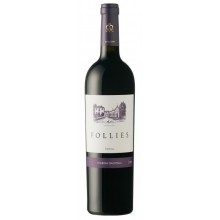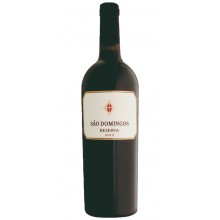There are 135 products.
Showing 1-12 of 135 item(s)
Caves São João 2019 Red Wine
€15.00
Wine House Portugal ,
5/ 5
<p>In the glass, Caves São João Red Wine shows a deep ruby color and opens with aromas of black plum, cherry, bergamot, and soft spices, layered with subtle toasty oak notes. On the palate, it is full-bodied, with silky tannins, lively acidity, and a long, mineral-driven finish. Serve at 16–18 °C and pair with grilled red meats, game dishes, or aged cheeses for the perfect experience</p>
6225

 0 review
0 reviewQuinta do Poço do Lobo Reserva 2019 Red Wine
€19.80
Wine House Portugal ,
5/ 5
<p>On the nose, Quinta do Poço do Lobo Reserva Red Wine offers a refined bouquet of wild berries, blackcurrant, cocoa, and tobacco, complemented by subtle spice and oak nuances. The palate is fresh and well-balanced, with polished tannins and a long, persistent finish. This wine pairs beautifully with grilled meats, game dishes, or aged cheeses, and it benefits from decanting or cellaring to further reveal its full potential. Serve between 16–18 °C for best expression.</p> <p></p> <p><span style="text-decoration:underline;"><strong>Years available for purchase. Price on request:</strong></span><span style="text-decoration:underline;"></span></p> <p>Quinta do Poço do Lobo Reserva Red Wine</p> <p>1995, 1996</p>
6227

 0 review
0 reviewFrei João Reserva 2018 Red Wine
€12.50
Wine House Portugal ,
5/ 5
<p>Frei João Reserva Red Wine displays a deep ruby color and opens with elegant aromas of ripe black fruits, dried figs, pine resin, and subtle herbal and spicy notes. On the palate, it is full-bodied and structured, with firm but polished tannins and a long, fresh finish. Recognized for its quality, Frei João Reserva Tinto has received numerous accolades, including a Gold Medal at the Portugal Wine Trophy and Bronze at the Asia Wine Trophy. With a solid structure and vibrant acidity, it’s ideal for cellaring and pairs beautifully with rich meat dishes and aged cheeses.</p> <p></p> <p><span style="text-decoration:underline;"><strong>Years available for purchase. Price on request:</strong></span></p> <p>1978, 1980, 1983, 1985, 1995</p> <p></p>
6234

 0 review
0 reviewCampolargo 2017 Red Wine
€38.85
Wine House Portugal ,
5/ 5
<p></p><p>Campolargo Pinot Noir is the ideal companion of game dishes.</p>
Camplre200

 0 review
0 reviewFollies Touriga Nacional 2015 Red Wine
€9.10
Wine House Portugal ,
5/ 5
<p></p><p>Aveleda Follies Touriga Nacional presents deep purple color. In the nose, the cassis, cherry and chocolate notes are evident and well integrated with wood notes. In the mouth this is a full bodied, balanced and elegant wine, with obvious notes of blackberries, figs and spices, complemented with firm and round tannins. The end is long and presents a creamy sensation.</p>
Foltn203

 0 review
0 reviewGrande Follies 2011 Red Wine
€24.80
Wine House Portugal ,
5/ 5
<p></p> <p>Grande Follies is produced by Quinta da Aveleda</p>
2107

 0 review
0 reviewCasa de Saima 2017 Red Wine
€7.80
Wine House Portugal ,
5/ 5
<p></p><p>Connected to the production of quality wines Casa de Saima is located in the center of the demarcated region of Bairrada with 20 hectares of vineyard</p> <p></p> <p></p>
Csar384

 0 review
0 reviewCasa de Saima Reserva 2017 Red Wine
€16.10
Wine House Portugal ,
5/ 5
<p></p> <p>Connected to the production of quality wines Casa de Saima is located in the center of the demarcated region of Bairrada with 20 hectares of vineyard, </p> <p></p>
Csrr385

 0 review
0 reviewKompassus Reserva 2021 Red Wine
€13.85
Wine House Portugal ,
5/ 5
<p></p><p>Since 2005 the company is called Kompassus, and still has a philosophy of wine production based on roots and family traditions. It is dedicated to the production of wines of excellence sustained by organic production methods and sustainable viticulture practices. The company is owned by João Póvoa, an ophthalmologist by profession, but a farmer by passion</p>
Kompr1133

 0 review
0 reviewSão Domingos Colheita 2017 Red Wine
€5.15
Wine House Portugal ,
5/ 5
<p></p><p>Since 1937, the São Domingos Caves produce sparkling wines, spirits and Bairrada and Dão wines</p>
Sdco1312

 0 review
0 reviewSão Domingos Reserva 2012 Red Wine
€7.10
Wine House Portugal ,
5/ 5
<p></p><p>Since 1937, the São Domingos Caves produce sparkling wines, spirits and Bairrada and Dão wines</p>
Sdrv1313

 0 review
0 review






